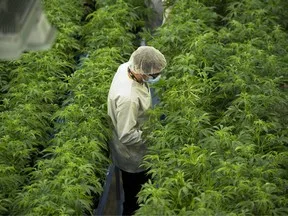
Article content
If much of the cannabis industry is ailing, so are some pot-related indicators of Canadians’ health a half decade into legalization, say physicians.
In an assessment released Tuesday in the Canadian Medical Association Journal (CMAJ), the percentage of Canadians using the drug increased from 22 per cent in 2017 to 27 per cent in 2022.
Article content
That’s been accompanied by a 20 per cent hike in emergency room visits for cannabis-related conditions in Ontario and Alberta, it says.
Advertisement 2
Story continues below
Article content
“Most of the relevant indicators point upwards, there’s been an increase in problems almost across the board which is not an ideal expectation,” said one of the report’s co-authors, Dr. Benedikt Fischer, an adjunct professor at at the Centre for Applied Research in Mental Health & Addiction at Simon Fraser University near Vancouver.
A common condition seen in emergency settings is cannabis hyperemesis syndrome (CHS), whose symptoms among chronic marijuana users include nausea and severe vomiting.
Dr. Eddy Lang has seen those symptoms many times in Calgary emergency rooms and notes the numbers aren’t huge but are nonetheless cause for concern.
“Based on our study in 2020, 0.3% of all emergency department (ED) visits are related to Cannabis or about 100 cases a month across the four adult sites (in Calgary),” said Lang, department head for emergency medicine at the University of Calgary’s Cumming School of Medicine.
“Hospitalizations are rare but six to 18 hours in the ED before improving enough to leave is not uncommon.”
A study of CHS visits in Ontario EDs shows their frequency was already dramatically increasing in the five years leading up to cannabis legalization in October, 2018.
Article content
Advertisement 3
Story continues below
Article content
But it found that once the industry became more commercially established during the pandemic, there was an “immediate” 50 per cent spike in CHS cases at hospitals in the province, a scenario that would likely be comparable to Alberta, said Lang.
And a study co-authored by Lang shows a 77 per cent and 36 per cent increase in unintentional cannabis ingestion among children and older adolescents respectively in Alberta urban EDs in early 2020 compared to 2013.
“We’re talking about kids who get into their parent’s edibles…it’s a 77 per cent increase but we’re still talking quite small numbers,” said Lang.
“If cannabis use is on the rise, the opportunity for kids to fall into accidental ingestion will go up.”
According to that study, CHS cases in Alberta had risen by 64 per cent.
“I have some concerns but it’s very complex, there are many moving parts,” said Lang.
One of those parts is the impact the COVID-19 pandemic had on cannabis users who were often isolated and used the drug to manage anxiety, he said, making that time period unusual.
That’s also led to more addictive behaviour, said Lang.
Advertisement 4
Story continues below
Article content
“With cannabis use disorder, you can become reliant on it – it’s rare but once you have so many more people in a population using it, it becomes more common and it becomes more of a concern,” said the Alberta Health Services physician.
One of the goals of legalizing cannabis and age-regulating its sale was to reduce its use by minors but research suggests consumption among under-age teens remains high in “Canada, which is a leader in the use of cannabis by young people,” said Simon Fraser’s Fischer.
Depending on the survey, says the paper, cannabis use among Canadian youth ranges from 30 to 50 per cent.
The end of prohibition has also increased concern over the impact of cannabis on young, developing brains with some pushing for a higher legal consumption age, which at 18 in Alberta, is the same for alcohol.
Quebec, by comparison has raised the minimum age of consumption to 21.
“It’s a risk for developmental capabilities but it’s not all cannabis use – it’s mostly risk if it’s used often and is high potency,” said Fischer.
Though higher potency cannabis was a pre-legalization reality, easier access to it since then presents a higher risk of psychosis, dependancy, mental illness and impaired driving, said Fischer.
Advertisement 5
Story continues below
Article content
To mitigate that, and the dangers of accidental ingestion, federal regulations limit the THC component in each package or container of cannabis product to 10 mg.
Lang said he’s not sure if that’s having a positive impact but he wouldn’t rule it out.
“If that were to reduce the number of hyperemesis cases I’d be all for it but I’m not sure there’s a connection,” he said.
The number of clients with primarily cannabis-related issues hasn’t increases since October, 2018, said counselers working at two Calgary substance abuse treatment facilities.
“The real epidemics are fentanyl and alcohol,” said TD Withecomb of Recovery Acres Calgary Society.
Cannabis problems do present themselves, but they’re usually accompanied by other substance dependencies, said Brad Oneil, program director at Recovery Calgary.
“Alcohol is the primary one but often we’ll find they’re combining it with pot…a lot of pot users will downplay the dependency aspect,” he said.
The authors of the CMAJ assessment say it’s too early for the available data to craft policy decisions and that “the relative novelty of legal cannabis, marketing efforts and the legal availability and regulation of cannabis as a consumption good may still be affecting consumer attitudes and behaviour after decades of prohibition.”
Advertisement 6
Story continues below
Article content
The report states that while the sky hasn’t fallen post-legalization, some of the hoped-for benefits also haven’t materialized.
“At this stage, cannabis legalization in Canada appears not to have been the public health disaster anticipated by some of its opponents, but it cannot be described as a comprehensive or unequivocal success for public health either,” said the authors.
And they point to improvements in social justice and equality with a vastly-reduced number of cannabis-related prosecutions and resulting criminal records as part of the equation.
According to Canada Justice, there were 16,700 adults charged with cannabis offences in 2017, the year prior to recreational legalization.
In 2020, that number had dropped to 2,550 while in Alberta, it had fallen to 263, a 27 per cent decrease.
Of those offences, nearly two-thirds were for importing or exporting the drug.
“Before legalization, many criminal cannabis arrests were the result of highly arbitrary or discriminatory (e.g., racialized) enforcement practices, with many focusing on circumstances of personal cannabis consumption,” stated the CMAJ report authors, which also includes and
Advertisement 7
Story continues below
Article content
Lang said he agrees with the CMAJ researchers, adding it’s not easy weighing the pros and cons of legalization.
“I suspect we’re better off overall with legalization – cannabis use is not going to go away,” he said, adding a black market and widespread cannabis use existed decades prior to 2018.
“Banning it again will just force it back into the black market.”
Fischer said he was a vocal advocate for recreational legalization but the past five years have tempered that, particularly after how the process has been commercialized, adding it needs to be reined in with more regulation.
“We’ve taken too much of a laissez faire approach, the industry is way too much in the driver’s seat,” he said.
There’s also a need for more stringent and comprehensive monitoring and study of legalization’s impact, said Fischer.
“There are data gaps, we need nationwide data and we have no treatment data,” he said.
More research is needed, he said, on how cannabis is possibly displacing the use of other harmful substances like alcohol.
Twitter: @BillKaufmannjrn
Article content



Comments
Postmedia is committed to maintaining a lively but civil forum for discussion and encourage all readers to share their views on our articles. Comments may take up to an hour for moderation before appearing on the site. We ask you to keep your comments relevant and respectful. We have enabled email notifications—you will now receive an email if you receive a reply to your comment, there is an update to a comment thread you follow or if a user you follow comments. Visit our Community Guidelines for more information and details on how to adjust your email settings.